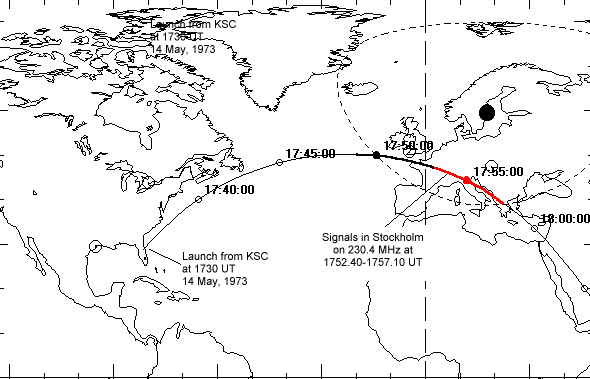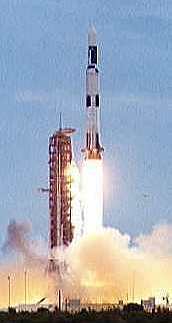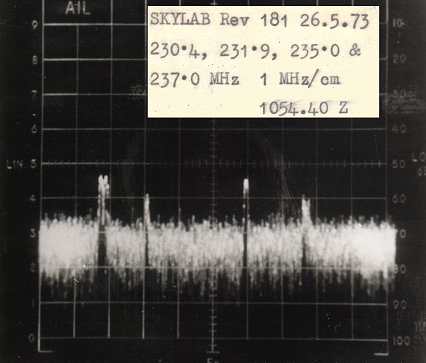
 Contents
Contents
This article contains
nothing sensational, but may be of some interest when comparing the
communications
systems of the International Space Station with that of one of
its
precursors, the Skylab space station. The Skylab communications system
was rooted in the technology of the 1960's. The Orbital Workshop, also
called Skylab 1, had an extensive set of P-band VHF transmitters for
telemetry.
Teletype uplink communications were also provided on VHF. When
astronauts
were occupying the workshop the docked Command & Service Module
(CSM)
provided voice communications through unified S-band.
|
(MHz) |
(W) |
type |
location |
(kbps) |
|
|
Kettering Group? |
|---|---|---|---|---|---|---|---|
|
|
|
|
|
|
|
|
|
|
|
|
|
|
|
|
|
|
|
|
|
|
|
|
|
|
|
|
|
|
|
|
|
|
|
|
|
|
|
|
|
|
|
|
|
|
|
|
|
|
|
|
|
|
| 1
ATM= Apollo Telescope Mount
2 Also recorded data and delayed emergency voice 3 Also recorded data 4 Alternating with the other ATM telemetry frequency (231.9 or 237.0 MHz) |
|||||||
A ground command teleprinter link was provided on 450.0 MHz. An FM receiver was located in the airlock module and it received 200 bps commands or 20 teletype characters per second. ATM commands were also received on this frequency.
The primary voice communication link between Skylab and the ground took place through the CSM at S-band, which is 2287.5 MHz for phase modulation (PM) and 2272.5 MHz for frequency modulation (FM). The PM signal contained voice on a 1.25 MHz subcarrier, telemetry on a 1.024 MHz subcarrier and pseudorandom noise ranging on baseband. In an emergency voice could be transmitted on baseband. The FM link was used primarily for TV or recorded voice and data playback. The voice was on baseband and the telemetry on a 1.024 MHz subcarrier. The power output to the antenna on the CSM was 12.3 W maximum.
VHF voice and ranging was used by the CSM until the crew had enterd the Orbital Workshop and activated it. During launch a duplex link with AM voice transmit on 259.7 MHz (at 2 W RF power) and receive on 296.8 MHz was used until Madrid had lost the signal. Consequently, Dick Flagg in Gainesville, Florida, received good voice on 259.7 MHz during the launch phase of Skylab-3. After the launch phase the VHF voice system was reconfigured to become simplex on 296.8 MHz. About four hours into the CSM mission the system would again go to the duplex mode, but this time with ranging to the Orbital Workshop. The ground would inhibit uplink transmissions on VHF when ranging was performed.
Skylab tracking
stations
were located at the Cape, Bermuda, Madrid, Canary Islands, Carnarvon,
Honeysuckle
Creek, Guam, Hawaii, Vandenberg, Texas. Exactly which stations
supported
VHF is unclear.

The Orbital Workshop separated from the S-II stage of the Saturn V at 1739.50 UT, at an altitude of 442 km, 1818 km downrange from the Cape (1). About thirteen minutes later the spacecraft had crossed the Atlantic and came within view of Stockholm. I picked up the signal on 230.4 MHz from the spacecraft at 1752.40-1757.10 UT (See map above). The signal can best be described a s a "chugging" sound. There were two peaks in spectrum 177 kHz apart.
In the early phases of
the
mission mostly only the 230.4 MHz was heard. On 19 May 1973 I also
picked
up a carrier on 231.9 MHz and telemetry on 235.0 MHz. My receiving
system
at that time covered neither 237.0 MHz nor 246.3 MHz. I
spot-checked
during the summer of 1973 and found only carrier being transmitted on
231.9
MHz except on June 20, 1973 when a 2 minute telemetry burst was
transmitted
on 230.4 MHz while passing the Madrid station. It took until 16
November
1973, the launch day of Skylab-4, for me to pick up telemetry on 231.9
MHz.

Image provided by G.E.
Perry